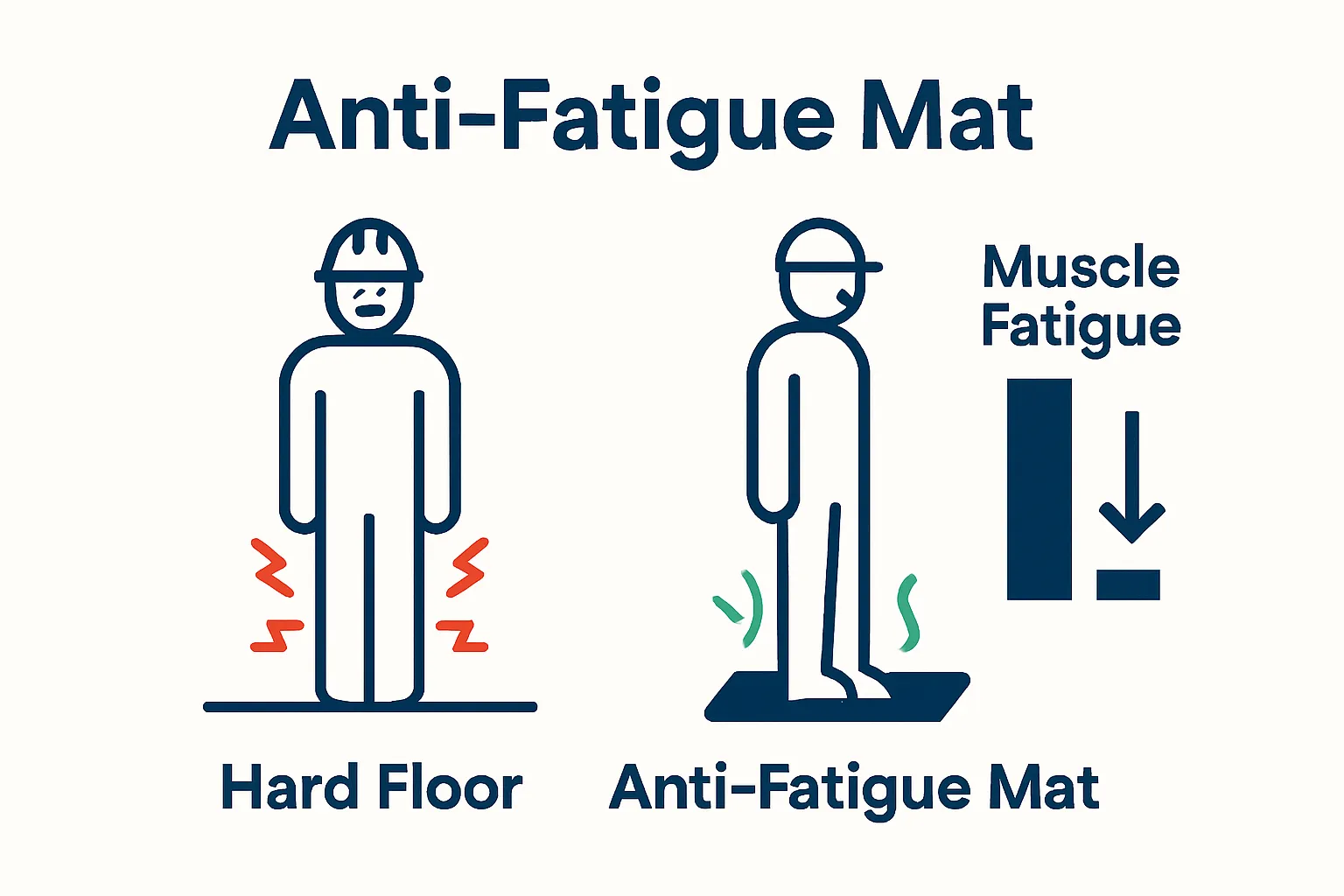Standing all day on hard floors might look harmless. Yet studies show workers forced to stand in one spot face a 50 percent higher risk of leg and back pain compared to those who use anti-fatigue mats. Most people assume an extra layer on the floor could not make a real difference. The real surprise is that these mats actually trigger micro-movements in your muscles every second you stand, shifting the entire experience of standing at work in ways you probably never imagined.
Table of Contents
- Defining Anti-Fatigue Mats: What Are They?
- The Importance Of Anti-Fatigue Mats In Work Environments
- How Anti-Fatigue Mats Work: The Science Behind Comfort
- Key Benefits Of Using Anti-Fatigue Mats In Various Industries
- Choosing The Right Anti-Fatigue Mat For Specific Needs
Quick Summary
| Takeaway | Explanation |
|---|---|
| Anti-fatigue mats enhance workplace comfort. | These mats provide support, helping reduce static muscle fatigue for workers standing for long periods. |
| They significantly reduce health risks. | Using anti-fatigue mats lowers the chances of developing musculoskeletal disorders and related chronic pain. |
| Improve productivity through reduced discomfort. | Employees experience increased concentration and job satisfaction when standing on these mats. |
| Proper mat selection is crucial. | Choosing mats based on the specific workplace environment ensures maximum ergonomic benefits and safety. |
| Investing in mats can improve morale. | Businesses often see lower absenteeism and enhanced employee well-being by using quality anti-fatigue mats. |
Defining Anti-Fatigue Mats: What Are They?
Anti-fatigue mats are specialized floor coverings engineered to provide comfort and support for workers who spend extended periods standing in one location. These innovative surface solutions are designed to reduce physical strain and minimize health risks associated with prolonged standing in workplace environments. Workplace ergonomics research demonstrates these mats play a critical role in worker well-being and productivity.
Core Design and Composition
Typically constructed from materials like rubber, vinyl, and foam, anti-fatigue mats create a slightly unstable surface that encourages subtle muscular movements. When you stand on these mats, your muscles continuously make micro-adjustments to maintain balance, which stimulates blood circulation and reduces static muscle fatigue. This design principle transforms what seems like a simple floor covering into a sophisticated ergonomic intervention.
Key characteristics of anti-fatigue mats include:
- Soft yet supportive surface that absorbs impact
- Varied thickness ranging from quarter-inch to three-quarters of an inch
- Materials engineered for durability and resilience
Workplace Applications
These mats find extensive use across diverse professional settings, from industrial manufacturing floors to commercial kitchens, retail checkout areas, and healthcare facilities. Occupational health experts recognize that workers in these environments face significant physical challenges from extended standing periods.
For those interested in learning more about specialized anti-fatigue solutions, our guide to anti-fatigue rubber mats provides deeper insights into selecting the right mat for specific workplace needs. By understanding the fundamental design and purpose of these mats, businesses can make informed decisions that prioritize employee comfort and health.
The Importance of Anti-Fatigue Mats in Work Environments
Anti-fatigue mats represent a critical workplace ergonomic solution that directly impacts worker health, productivity, and overall operational efficiency. Workplace health research indicates that prolonged standing can lead to significant musculoskeletal challenges, making these specialized mats an essential investment for organizations prioritizing employee well-being.
Physical Health Implications
Standing for extended periods creates substantial stress on the human body, particularly affecting the legs, lower back, shoulders, and neck. Anti-fatigue mats mitigate these risks by introducing a dynamic surface that encourages subtle movement and reduces static muscle strain. When workers stand on these mats, their muscles engage in continuous micro-adjustments, which promotes better blood circulation and reduces the likelihood of developing chronic pain conditions.
Key health benefits include:
- Reduced risk of musculoskeletal disorders
- Decreased lower back and leg strain
- Improved overall worker comfort and mobility
Productivity and Workplace Performance
Beyond physical health, anti-fatigue mats directly influence workplace productivity. Employees experiencing less physical discomfort demonstrate higher levels of concentration, reduced fatigue, and improved job satisfaction. Our guide to anti-fatigue industrial mats explores how strategic mat placement can transform workplace ergonomics and operational effectiveness.
Companies investing in these mats often observe tangible improvements in worker performance, with reduced absenteeism and enhanced overall workplace morale. The relatively modest investment in high-quality anti-fatigue mats can yield significant returns through improved employee well-being and sustained productivity.
How Anti-Fatigue Mats Work: The Science Behind Comfort
Anti-fatigue mats leverage sophisticated biomechanical principles to transform workplace standing experiences. Ergonomic research reveals that these specialized surfaces go far beyond simple floor coverings, functioning as advanced ergonomic interventions designed to counteract the physiological stress of prolonged standing.
Biomechanical Movement Stimulation
The core scientific mechanism of anti-fatigue mats involves creating a slightly unstable surface that triggers continuous, subtle muscular engagement. When workers stand on these mats, their bodies make constant micro-adjustments to maintain balance. These imperceptible movements stimulate blood circulation, activate muscle groups, and prevent the harmful static positioning that occurs on rigid, flat surfaces.

Key biomechanical activation principles include:
- Subtle surface variations that challenge postural stability
- Encouragement of continuous muscle micro-movements
- Reduction of hydrostatic pressure in leg muscles
Physiological Response and Comfort Mechanism
Unlike traditional hard floors, anti-fatigue mats create a dynamic interaction between the human body and the standing surface. The mat’s compressible material absorbs shock and distributes body weight more evenly, reducing stress on joints and muscle groups. This design promotes natural body movement and prevents the accumulation of static muscle tension that leads to fatigue and discomfort.
Our practical guide to selecting rubber anti-fatigue mats provides deeper insights into how different mat materials enhance these physiological benefits. By understanding the intricate science behind these mats, businesses can make informed decisions that prioritize worker health and operational efficiency.
Key Benefits of Using Anti-Fatigue Mats in Various Industries
Anti-fatigue mats provide substantial advantages across diverse professional environments, addressing critical workplace health and safety challenges. Workplace safety research demonstrates that these specialized floor coverings offer comprehensive benefits extending far beyond basic comfort.
Workplace Safety and Risk Reduction
Industrial and commercial settings face significant challenges related to worker health and potential workplace injuries. Anti-fatigue mats serve as a critical intervention, significantly reducing the risk of musculoskeletal disorders and slip-related accidents. By creating a supportive surface that encourages movement and absorbs shock, these mats help businesses minimize potential worker compensation claims and maintain higher safety standards.
Key safety advantages include:
- Reduced risk of workplace injuries
- Enhanced slip and fall prevention
- Improved overall workplace ergonomics
Industry-Specific Performance Enhancements
Different industries experience unique benefits from anti-fatigue mat implementation. Manufacturing facilities observe improved worker productivity, while healthcare environments see reduced physical strain for medical professionals who spend extensive hours standing. Retail spaces benefit from enhanced employee comfort, directly translating to improved customer service interactions.
Our comprehensive guide to industrial anti-fatigue mats offers deeper insights into industry-specific applications. By understanding these targeted benefits, businesses can strategically implement anti-fatigue solutions that directly address their unique operational challenges and worker well-being requirements.
Choosing the Right Anti-Fatigue Mat for Specific Needs
Selecting an appropriate anti-fatigue mat requires careful consideration of workplace environment, specific operational demands, and unique ergonomic requirements. Workplace ergonomics research emphasizes the importance of tailored solutions that address distinct industrial and commercial challenges.
Material Composition and Environmental Factors
The selection process begins with understanding the specific environmental conditions where the mat will be used. Different materials offer unique advantages depending on the workplace setting. Rubber mats excel in wet environments, providing superior slip resistance and durability. Foam mats offer maximum cushioning for extended standing periods, while specialized composite materials can withstand harsh chemical exposures in industrial settings.
Critical selection criteria include:
- Resistance to specific workplace chemicals
- Temperature tolerance
- Durability under heavy foot traffic
- Ease of cleaning and maintenance
Application-Specific Performance Considerations
Workplace ergonomics demand a nuanced approach to mat selection. Manufacturing floors require different mat characteristics compared to healthcare settings or retail environments. The thickness, surface texture, and material composition must align precisely with the specific physical demands of the workspace. A thin, hard surface might work well in areas with frequent equipment movement, while thicker, more cushioned mats are ideal for stationary work stations.
To help you understand how anti-fatigue mats differ by material and performance, the following table summarizes key material types and their ideal workplace applications.
| Material Type | Key Properties | Suitable Environments |
|---|---|---|
| Rubber | High durability, slip resistance, absorbs impact | Wet areas, industrial, commercial |
| Foam | Maximum cushioning, moderate durability | Offices, retail, dry environments |
| Vinyl | Easy to clean, moderate softness | Light industrial, healthcare, labs |
| Composite | Chemical resistance, supports heavy loads | Manufacturing, chemical plants |
| Gel | Superior comfort, adapts to foot contours | Medical settings, retail counters |
Our comprehensive guide to selecting industrial anti-fatigue mats provides in-depth insights into matching mat characteristics with specific workplace requirements. By understanding these critical selection parameters, businesses can make informed decisions that optimize worker comfort, safety, and productivity.

Discover the Comfort and Benefits of Anti-Fatigue Mats with Mats4U
Have you noticed the strain and fatigue that comes from long hours of standing at work? As highlighted in the article, anti-fatigue mats are crucial for reducing muscle tension and supporting employee well-being. If you are ready to experience less discomfort and boost productivity, it is time to explore mats designed to tackle these challenges head-on. Our Anti-Fatigue Mats Collection brings you durable, high-performance solutions specifically created for demanding commercial and industrial environments. Find a wide range of options that cater to different needs, spacings, and budgets.
Protect your team and your business from the costs of preventable fatigue and injuries. Visit the Mats4U website to find the best mat for your workplace. Shop now and enjoy competitive pricing and free delivery on qualifying orders. Take the first step toward a safer and more comfortable workday with Anti-Fatigue Mats from Mats4U or explore our Comfort Range for additional ergonomic solutions.
Frequently Asked Questions
What is an anti-fatigue mat?
Anti-fatigue mats are specialized floor coverings designed to provide comfort and support for individuals who spend extended periods standing in one location. They help reduce physical strain and minimize health risks associated with prolonged standing.
How do anti-fatigue mats work?
Anti-fatigue mats work by creating a slightly unstable surface that encourages subtle muscular adjustments. This continuous muscle engagement stimulates blood circulation and helps reduce static muscle fatigue.
What are the key benefits of using anti-fatigue mats in the workplace?
Key benefits include reduced risk of musculoskeletal disorders, decreased strain on the lower back and legs, improved overall worker comfort, and enhanced productivity and job satisfaction.
How can I choose the right anti-fatigue mat for my needs?
When selecting an anti-fatigue mat, consider the environment where it will be used, the specific operational demands, material composition, and thickness. Different settings may require different mat characteristics for optimal comfort and safety.







